HUMMER H3 2009 Manual Online
Manufacturer: HUMMER, Model Year: 2009, Model line: H3, Model: HUMMER H3 2009Pages: 382, PDF Size: 1.99 MB
Page 81 of 382

5. After the engine has started, turn
the key to LOCK/OFF, and
remove the key. Insert the key to
be programmed and turn it to
ON/RUN within ten seconds of
removing the previous key.
The security light turns off once
the key has been programmed.
6. Repeat the Steps 1 through 5
if additional keys are to be
programmed.
If the security light comes on and
stays on while driving, the engine
will restart if you turn it off. However,
the theft-deterrent system is not
working properly and must be
serviced by your dealer/retailer.
The vehicle is not protected by the
theft-deterrent system at this time.
In an emergency, contact Roadside
Assistance. SeeRoadside Service
on page 7-6.
Do not leave the key or device that
disarms or deactivates the theft
deterrent system in the vehicle.Starting and
Operating Your
Vehicle
New Vehicle Break-In
Notice:The vehicle does
not need an elaborate break-in.
But it will perform better in
the long run if you follow these
guidelines:
Keep your speed at 55 mph
(88 km/h) or less for the
�rst 500 miles (805 km).
Do not drive at any one
constant speed, fast or slow,
for the �rst 500 miles (805 km).
Do not make full-throttle
starts. Avoid downshifting to
brake or slow the vehicle.
Avoid making hard stops for
the �rst 200 miles (322 km)
or so. During this time the
new brake linings are not yet
broken in. Hard stops with new
linings can mean premature
wear and earlier replacement.
Follow this breaking-in
guideline every time you get
new brake linings.
Do not tow a trailer during
break-in. SeeTowing a
Trailer on page 4-42for the
trailer towing capabilities of the
vehicle and more information.
Following break-in, engine
speed and load can be gradually
increased.
Features and Controls 2-15
Page 82 of 382
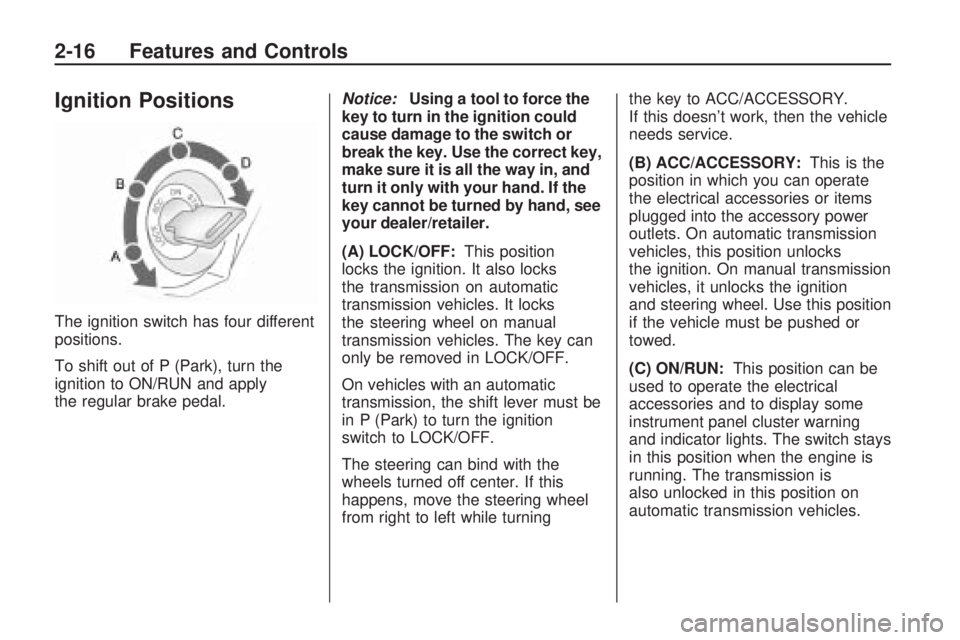
Ignition Positions
The ignition switch has four different
positions.
To shift out of P (Park), turn the
ignition to ON/RUN and apply
the regular brake pedal.Notice:Using a tool to force the
key to turn in the ignition could
cause damage to the switch or
break the key. Use the correct key,
make sure it is all the way in, and
turn it only with your hand. If the
key cannot be turned by hand, see
your dealer/retailer.
(A) LOCK/OFF:This position
locks the ignition. It also locks
the transmission on automatic
transmission vehicles. It locks
the steering wheel on manual
transmission vehicles. The key can
only be removed in LOCK/OFF.
On vehicles with an automatic
transmission, the shift lever must be
in P (Park) to turn the ignition
switch to LOCK/OFF.
The steering can bind with the
wheels turned off center. If this
happens, move the steering wheel
from right to left while turningthe key to ACC/ACCESSORY.
If this doesn’t work, then the vehicle
needs service.
(B) ACC/ACCESSORY:This is the
position in which you can operate
the electrical accessories or items
plugged into the accessory power
outlets. On automatic transmission
vehicles, this position unlocks
the ignition. On manual transmission
vehicles, it unlocks the ignition
and steering wheel. Use this position
if the vehicle must be pushed or
towed.
(C) ON/RUN:This position can be
used to operate the electrical
accessories and to display some
instrument panel cluster warning
and indicator lights. The switch stays
in this position when the engine is
running. The transmission is
also unlocked in this position on
automatic transmission vehicles.
2-16 Features and Controls
Page 83 of 382
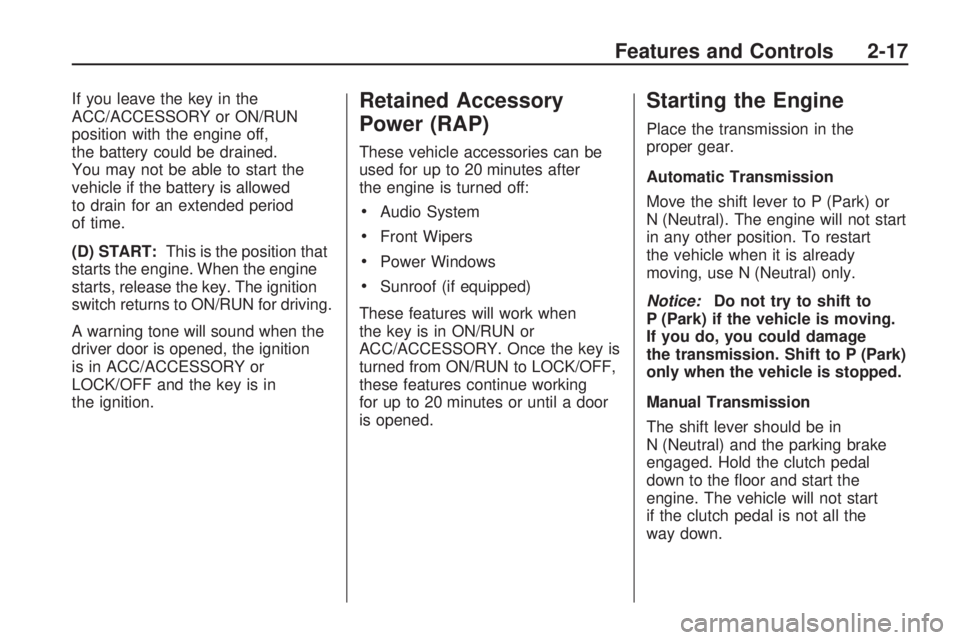
If you leave the key in the
ACC/ACCESSORY or ON/RUN
position with the engine off,
the battery could be drained.
You may not be able to start the
vehicle if the battery is allowed
to drain for an extended period
of time.
(D) START:This is the position that
starts the engine. When the engine
starts, release the key. The ignition
switch returns to ON/RUN for driving.
A warning tone will sound when the
driver door is opened, the ignition
is in ACC/ACCESSORY or
LOCK/OFF and the key is in
the ignition.Retained Accessory
Power (RAP)
These vehicle accessories can be
used for up to 20 minutes after
the engine is turned off:
Audio System
Front Wipers
Power Windows
Sunroof (if equipped)
These features will work when
the key is in ON/RUN or
ACC/ACCESSORY. Once the key is
turned from ON/RUN to LOCK/OFF,
these features continue working
for up to 20 minutes or until a door
is opened.
Starting the Engine
Place the transmission in the
proper gear.
Automatic Transmission
Move the shift lever to P (Park) or
N (Neutral). The engine will not start
in any other position. To restart
the vehicle when it is already
moving, use N (Neutral) only.
Notice:Do not try to shift to
P (Park) if the vehicle is moving.
If you do, you could damage
the transmission. Shift to P (Park)
only when the vehicle is stopped.
Manual Transmission
The shift lever should be in
N (Neutral) and the parking brake
engaged. Hold the clutch pedal
down to the �oor and start the
engine. The vehicle will not start
if the clutch pedal is not all the
way down.
Features and Controls 2-17
Page 84 of 382
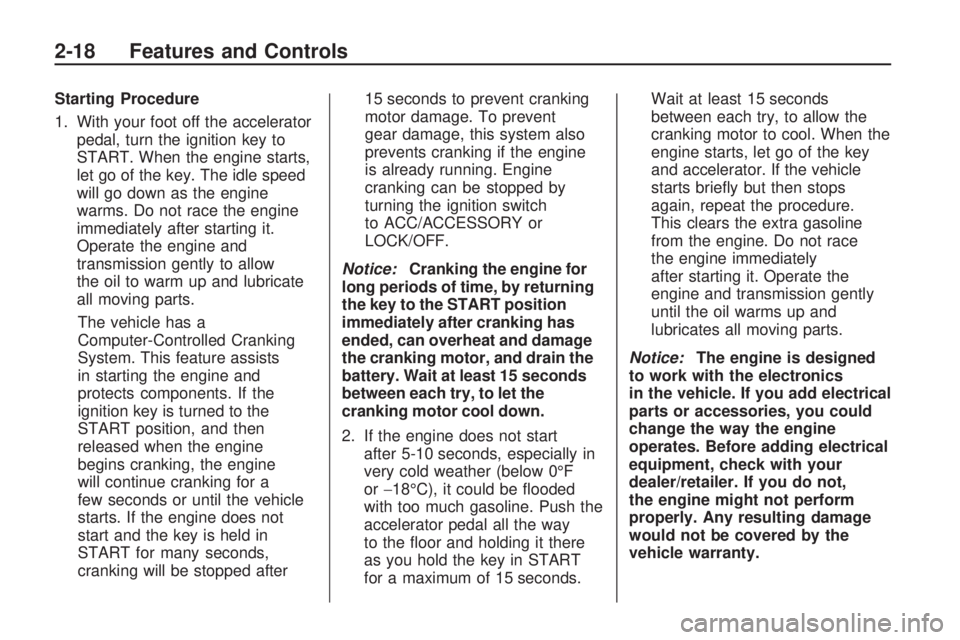
Starting Procedure
1. With your foot off the accelerator
pedal, turn the ignition key to
START. When the engine starts,
let go of the key. The idle speed
will go down as the engine
warms. Do not race the engine
immediately after starting it.
Operate the engine and
transmission gently to allow
the oil to warm up and lubricate
all moving parts.
The vehicle has a
Computer-Controlled Cranking
System. This feature assists
in starting the engine and
protects components. If the
ignition key is turned to the
START position, and then
released when the engine
begins cranking, the engine
will continue cranking for a
few seconds or until the vehicle
starts. If the engine does not
start and the key is held in
START for many seconds,
cranking will be stopped after15 seconds to prevent cranking
motor damage. To prevent
gear damage, this system also
prevents cranking if the engine
is already running. Engine
cranking can be stopped by
turning the ignition switch
to ACC/ACCESSORY or
LOCK/OFF.
Notice:Cranking the engine for
long periods of time, by returning
the key to the START position
immediately after cranking has
ended, can overheat and damage
the cranking motor, and drain the
battery. Wait at least 15 seconds
between each try, to let the
cranking motor cool down.
2. If the engine does not start
after 5-10 seconds, especially in
very cold weather (below 0°F
or−18°C), it could be �ooded
with too much gasoline. Push the
accelerator pedal all the way
to the �oor and holding it there
as you hold the key in START
for a maximum of 15 seconds.Wait at least 15 seconds
between each try, to allow the
cranking motor to cool. When the
engine starts, let go of the key
and accelerator. If the vehicle
starts brie�y but then stops
again, repeat the procedure.
This clears the extra gasoline
from the engine. Do not race
the engine immediately
after starting it. Operate the
engine and transmission gently
until the oil warms up and
lubricates all moving parts.
Notice:The engine is designed
to work with the electronics
in the vehicle. If you add electrical
parts or accessories, you could
change the way the engine
operates. Before adding electrical
equipment, check with your
dealer/retailer. If you do not,
the engine might not perform
properly. Any resulting damage
would not be covered by the
vehicle warranty.
2-18 Features and Controls
Page 85 of 382
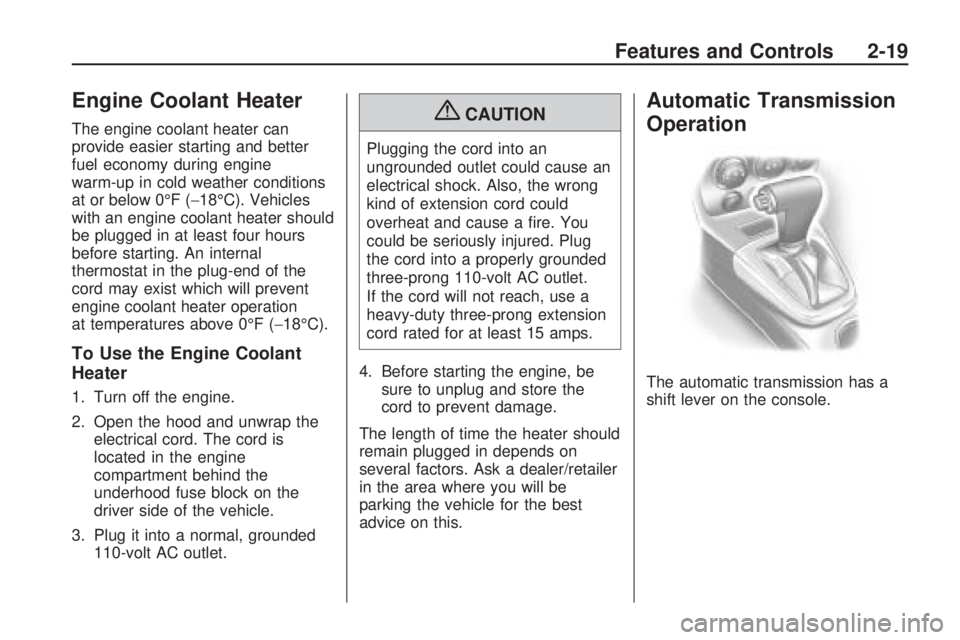
Engine Coolant Heater
The engine coolant heater can
provide easier starting and better
fuel economy during engine
warm-up in cold weather conditions
at or below 0°F (−18°C). Vehicles
with an engine coolant heater should
be plugged in at least four hours
before starting. An internal
thermostat in the plug-end of the
cord may exist which will prevent
engine coolant heater operation
at temperatures above 0°F (−18°C).
To Use the Engine Coolant
Heater
1. Turn off the engine.
2. Open the hood and unwrap the
electrical cord. The cord is
located in the engine
compartment behind the
underhood fuse block on the
driver side of the vehicle.
3. Plug it into a normal, grounded
110-volt AC outlet.
{CAUTION
Plugging the cord into an
ungrounded outlet could cause an
electrical shock. Also, the wrong
kind of extension cord could
overheat and cause a �re. You
could be seriously injured. Plug
the cord into a properly grounded
three-prong 110-volt AC outlet.
If the cord will not reach, use a
heavy-duty three-prong extension
cord rated for at least 15 amps.
4. Before starting the engine, be
sure to unplug and store the
cord to prevent damage.
The length of time the heater should
remain plugged in depends on
several factors. Ask a dealer/retailer
in the area where you will be
parking the vehicle for the best
advice on this.
Automatic Transmission
Operation
The automatic transmission has a
shift lever on the console.
Features and Controls 2-19
Page 86 of 382
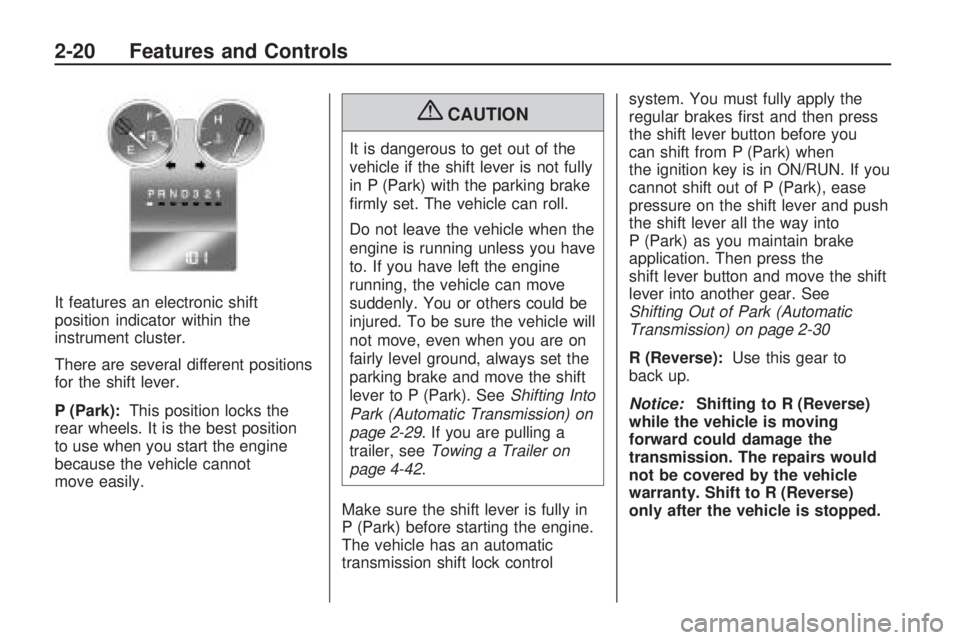
It features an electronic shift
position indicator within the
instrument cluster.
There are several different positions
for the shift lever.
P (Park):This position locks the
rear wheels. It is the best position
to use when you start the engine
because the vehicle cannot
move easily.
{CAUTION
It is dangerous to get out of the
vehicle if the shift lever is not fully
in P (Park) with the parking brake
�rmly set. The vehicle can roll.
Do not leave the vehicle when the
engine is running unless you have
to. If you have left the engine
running, the vehicle can move
suddenly. You or others could be
injured. To be sure the vehicle will
not move, even when you are on
fairly level ground, always set the
parking brake and move the shift
lever to P (Park). SeeShifting Into
Park (Automatic Transmission) on
page 2-29. If you are pulling a
trailer, seeTowing a Trailer on
page 4-42.
Make sure the shift lever is fully in
P (Park) before starting the engine.
The vehicle has an automatic
transmission shift lock controlsystem. You must fully apply the
regular brakes �rst and then press
the shift lever button before you
can shift from P (Park) when
the ignition key is in ON/RUN. If you
cannot shift out of P (Park), ease
pressure on the shift lever and push
the shift lever all the way into
P (Park) as you maintain brake
application. Then press the
shift lever button and move the shift
lever into another gear. See
Shifting Out of Park (Automatic
Transmission) on page 2-30
R (Reverse):Use this gear to
back up.
Notice:Shifting to R (Reverse)
while the vehicle is moving
forward could damage the
transmission. The repairs would
not be covered by the vehicle
warranty. Shift to R (Reverse)
only after the vehicle is stopped.
2-20 Features and Controls
Page 87 of 382

To rock the vehicle back and forth to
get out of snow, ice, or sand without
damaging the transmission, see
If Your Vehicle is Stuck in Sand,
Mud, Ice, or Snow on page 4-33
N (Neutral):In this position, the
engine does not connect with
the wheels. To restart the engine
when the vehicle is already moving,
use N (Neutral) only.
{CAUTION
Shifting into a drive gear while the
engine is running at high speed is
dangerous. Unless your foot is
�rmly on the brake pedal, the
vehicle could move very rapidly.
You could lose control and hit
people or objects. Do not shift into
a drive gear while the engine is
running at high speed.Notice:Shifting out of P (Park)
or N (Neutral) with the engine
running at high speed may
damage the transmission. The
repairs would not be covered by
the vehicle warranty. Be sure
the engine is not running at high
speed when shifting the vehicle.
D (Drive):This position is for
normal driving. It provides the best
fuel economy. If you need more
power for passing, and you are:
Going less than about 35 mph
(55 km/h), push the accelerator
pedal about halfway down.
Going about 35 mph (55 km/h) or
more, push the accelerator all
the way down.
Downshifting the transmission in
slippery road conditions could result
in skidding, see “Skidding” under
Loss of Control on page 4-12.D (Drive) can be used when towing
a trailer. You may want to shift
the transmission to 3 (Third) or,
if necessary, a lower gear if
the transmission shifts too often
under heavy loads or in hilly
conditions.
3 (Third):This position is also used
for normal driving. However it
reduces vehicle speed more than
D (Drive) without using the brakes.
You might choose 3 (Third) instead
of D (Drive) when driving on hilly or
winding roads, or when towing a
trailer, so there is less shifting
between gears, or when going
down a steep hill.
2 (Second):This position reduces
vehicle speed even more than
3 (Third) without using the brakes.
You can use 2 (Second) on hills.
It can help control vehicle speed as
you go down steep mountain roads,
but then you would also want to use
the brakes off and on.
Features and Controls 2-21
Page 88 of 382

1 (First):This position reduces
vehicle speed even more than
2 (Second) without using the brakes.
You can use it on very steep hills,
or in deep snow or mud. If the
shift lever is put in 1 (First) while the
vehicle is moving forward, the
transmission will not shift into �rst
gear until the vehicle is going slowly
enough.
Notice:Spinning the tires or
holding the vehicle in one place
on a hill using only the
accelerator pedal may damage
the transmission. The repair
will not be covered by the vehicle
warranty. If you are stuck, do
not spin the tires. When stopping
on a hill, use the brakes to
hold the vehicle in place.
Hill Start Assist
H3 and H3T vehicles have a Hill
Start Assist feature, which may be
useful when stopped on a grade.
SeeBraking on page 4-3for
more information.
Manual Transmission
Operation
This is the shift pattern.
Vehicles with a manual transmission
operate as described below:
1 (First):Press the clutch pedal
and shift into 1 (First). Then slowly
let up on the clutch pedal as
you slowly press down on the
accelerator pedal.
You can shift into 1 (First) when
you are going less than 20 mph
(30 km/h). If you have come to a
complete stop and it is hard toshift into 1 (First), put the shift lever
in Neutral and let up on the
clutch. Then press the clutch pedal
back down and shift into 1 (First).
2 (Second):Press the clutch pedal
as you let up on the accelerator
pedal and shift into 2 (Second).
Then, slowly let up on the clutch
pedal as you press the accelerator
pedal.
3 (Third), 4 (Fourth) and 5 (Fifth):
Shift into 3 (Third), 4 (Fourth) and
5 (Fifth) the same way you do
for 2 (Second). Slowly let up on the
clutch pedal as you press the
accelerator pedal.
To stop, let up on the accelerator
pedal and press the brake
pedal. Just before the vehicle stops,
press the clutch pedal and the
brake pedal, and shift to Neutral.
Neutral:Use this position when you
start or idle the engine.
2-22 Features and Controls
Page 89 of 382
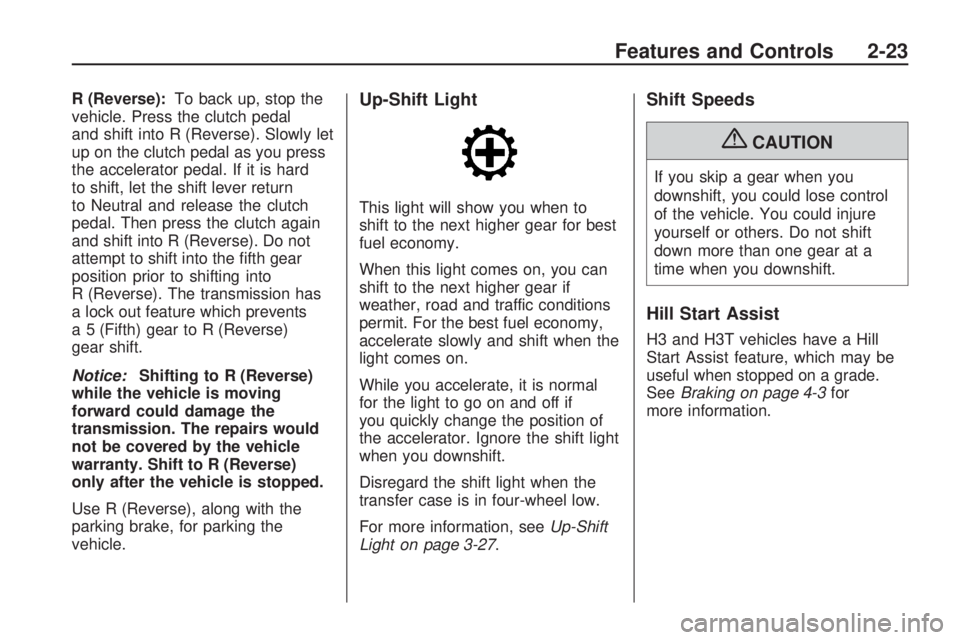
R (Reverse):To back up, stop the
vehicle. Press the clutch pedal
and shift into R (Reverse). Slowly let
up on the clutch pedal as you press
the accelerator pedal. If it is hard
to shift, let the shift lever return
to Neutral and release the clutch
pedal. Then press the clutch again
and shift into R (Reverse). Do not
attempt to shift into the �fth gear
position prior to shifting into
R (Reverse). The transmission has
a lock out feature which prevents
a 5 (Fifth) gear to R (Reverse)
gear shift.
Notice:Shifting to R (Reverse)
while the vehicle is moving
forward could damage the
transmission. The repairs would
not be covered by the vehicle
warranty. Shift to R (Reverse)
only after the vehicle is stopped.
Use R (Reverse), along with the
parking brake, for parking the
vehicle.Up-Shift Light
This light will show you when to
shift to the next higher gear for best
fuel economy.
When this light comes on, you can
shift to the next higher gear if
weather, road and traffic conditions
permit. For the best fuel economy,
accelerate slowly and shift when the
light comes on.
While you accelerate, it is normal
for the light to go on and off if
you quickly change the position of
the accelerator. Ignore the shift light
when you downshift.
Disregard the shift light when the
transfer case is in four-wheel low.
For more information, seeUp-Shift
Light on page 3-27.
Shift Speeds
{CAUTION
If you skip a gear when you
downshift, you could lose control
of the vehicle. You could injure
yourself or others. Do not shift
down more than one gear at a
time when you downshift.
Hill Start Assist
H3 and H3T vehicles have a Hill
Start Assist feature, which may be
useful when stopped on a grade.
SeeBraking on page 4-3for
more information.
Features and Controls 2-23
Page 90 of 382

Full-Time Four-Wheel
Drive
Full-Time Four-Wheel Drive sends
engine power to all four wheels
for extra traction. To get the most
out of Full-Time Four-Wheel Drive,
you must be familiar with its
operation.
Transfer Case Buttons
The transfer case buttons are
located to the right of the instrument
panel cluster. Use these switches to
shift into and out of the different
Full-Time Four-Wheel Drive modes.4
m(Four-Wheel High):This
setting is used for driving in most
street and highway situations.
You can also use this setting for
light or variable off-road conditions.
N (Neutral):Shift the transfer
case to Neutral only when towing
the vehicle. SeeRecreational
Vehicle Towing on page 4-40or
Towing Your Vehicle on page 4-40
for more information.
Notice:Driving on pavement in
Four-Wheel High Lock or Four
Wheel Low Lock for extended
periods may cause premature
wear on the vehicle powertrain
and tires. Do not drive in
Four-Wheel High Lock or
Four-Wheel Low Lock on
pavement for extended periods.
4
mQ(Four-Wheel-High Lock):
Use this setting when you need
extra traction in most off-road
situations such as sand, mud, snow
or level, rocky trails.Notice:Operating the vehicle in
Four-Wheel-Low Lock above
30 mph (48 km/h) for any
extended period of time could
cause damage to the transfer
case. Do not operate the vehicle
in Four-Wheel-Low Lock above
30 mph (48 km/h) for extended
periods.
4
nQ(Four-Wheel-Low Lock):
This setting delivers extra torque to
all four wheels and is used for
extreme off-road conditions.
If the vehicle has locking axles,
they can be locked for additional
traction in extreme off-road
situations. SeeLocking Rear Axle
on page 4-8andLocking Front Axle
on page 4-9.
Indicator lights in the buttons show
which setting the transfer case
is in. The indicator lights will come
on brie�y when the ignition is in
ON/RUN. The If the lights do
not come on, take the vehicle to
your dealer/retailer for service.
2-24 Features and Controls